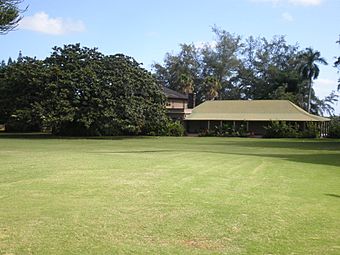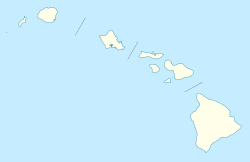Grove Farm (Lihue, Hawaii) facts for kids
|
Grove Farm
|
|

Wilcox residence, Grove Farm, Kauaʻi
|
|
| Location | On Hawaii Route 58, southeast of Lihue, Hawaii |
|---|---|
| Area | 81.79 acres (33.10 ha) |
| Built | 1854 |
| Architect | Charles William Dickey |
| NRHP reference No. | 74000722 (original) 78003436 (increase) |
Quick facts for kids Significant dates |
|
| Added to NRHP | June 25, 1974 |
| Boundary increase | December 8, 1978 |
Grove Farm is a special historical place on Kauaʻi, one of the beautiful Hawaiian Islands. It started as a large farm, or plantation, growing sugarcane. Today, it helps us remember the history of farming and life in Hawaii long ago. You can even visit parts of it as a museum!
Contents
The Story of Grove Farm
Starting a Sugar Plantation
In 1854, a man named Hermann A. Widemann came from Germany and started Grove Farm. It was one of the first places in Hawaii to grow a lot of sugarcane. Sugarcane was a very important crop for Hawaii's economy.
During the American Civil War (1861-1865), people in America needed more sugar. This made Grove Farm's sugar very popular. Widemann later moved to Honolulu to become a judge.
The Wilcox Family Takes Over
In 1864, Widemann rented Grove Farm to its manager, George Norton Wilcox. Wilcox later bought the farm, and his family owned it for over 100 years. He was a smart farmer.
Wilcox built a special system to bring water from the rainy mountains to the drier fields. This was called an irrigation system. It helped the sugarcane grow much better. Other farmers in Hawaii soon copied his clever idea.
Growing the Farm and Building Homes
In 1881, the farm grew much larger when Princess Ruth Keʻelikolani sold some land to Grove Farm. This made the farm about ten times bigger!
The Wilcox family also built many homes. In 1903, they hired an architect named Charles William Dickey to design a house for Ralph Wilcox and his wife. Dickey also updated the main house in 1915, making its rooms larger and more open.
From 1913 to 1917, small houses were built for the people who worked on the farm. These homes were called Kaipu Camp. The name came from a Hawaiian word for a Chinese foreman, or supervisor, at the plantation.
Exploring the Estate Buildings
The main house at Grove Farm is quite grand. It has bedrooms, bathrooms, a writing room, and a library on the first floor. A big staircase leads to more bedrooms upstairs.
Behind the main house, there is a cool, six-sided building called a gazebo. It looks like a Japanese teahouse and was built in 1898. There's also a guest cottage from around 1890 and another small house built in 1877 for George Wilcox. An office building was added in 1884, along with sheds and a garage.
Changes Over Time
George Wilcox passed away in 1933. He left the farm to his nieces and nephews. During World War II, Grove Farm started growing other foods besides sugar. This helped feed the people and soldiers living in Hawaii.
In 1948, Grove Farm bought another large farm called McBryde plantation. This included the Old Sugar Mill of Koloa. By 1974, Grove Farm rented out its sugar production to another company. The company then started to focus on building homes and resorts.
A Historic Landmark
Grove Farm is a very important place. On June 25, 1974, it was added to the National Register of Historic Places listings in Hawaii. This means it is recognized as a special historical site in the United States. Its protected area was later made larger in 1978.
Today, the main house is a private museum called the Grove Farm Sugar Plantation Museum. You can take tours there by making an appointment. It's located on Hawaii Route 58.
Trains and Golf Courses
Grove Farm also had special narrow-gauge trains. These trains ran on smaller tracks than regular trains. They were used to carry sugarcane. Some of these restored trains are now stored nearby in Puhi. You can sometimes ride them at the Lihue Plantation Sugar Mill.
In the 1990s, sugarcane farming stopped in the area. A golf course called Puakea was being built when a big storm, Hurricane Iniki, hit in 1992. The golf course later opened with ten holes in 1997 and is now a full 18-hole course.
New Ownership and Future Plans
In 2000, a person named Steve Case bought the Grove Farm Company (but not the museum). He also bought the nearby Lihue plantation in 2001. This made him own a very large amount of land, about 40,000 acres. Case's grandfather had even worked on the plantation a long time ago.
Case has suggested new building plans for the area. These plans focus on "green building," which means using methods that are good for the environment.



